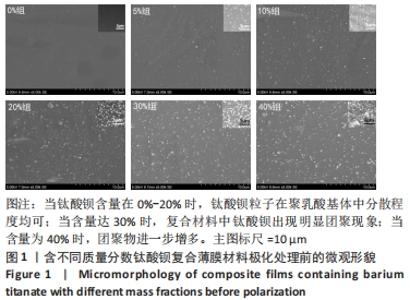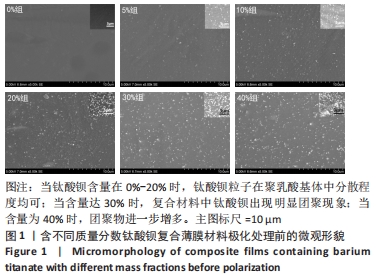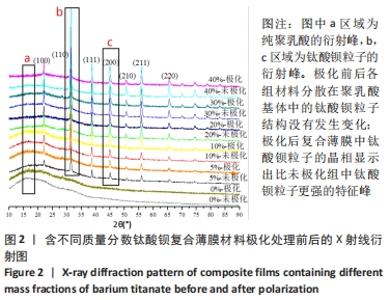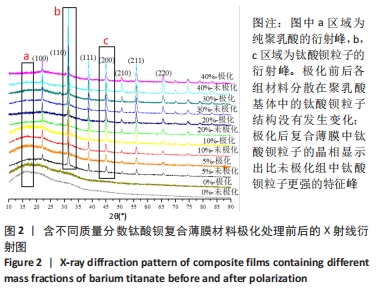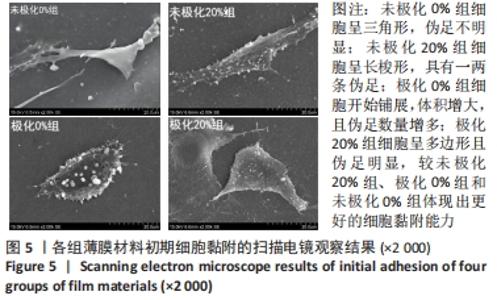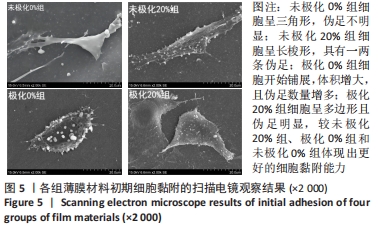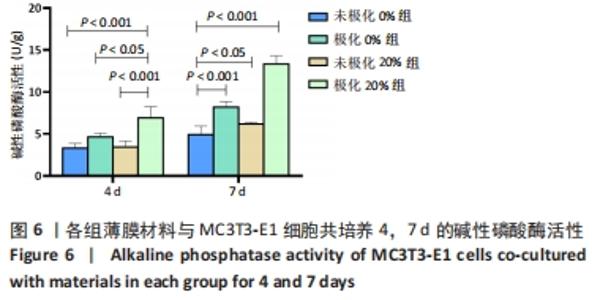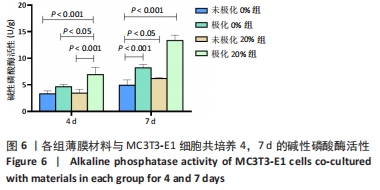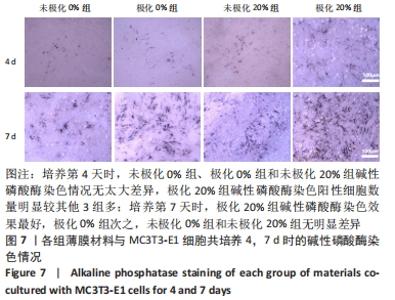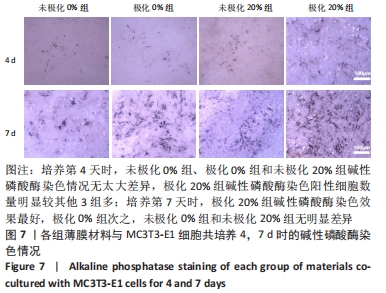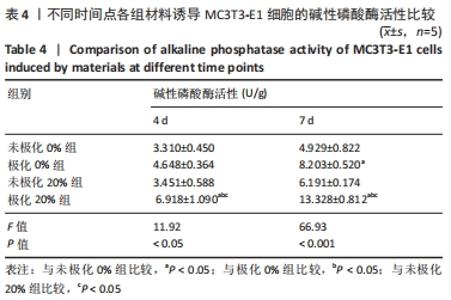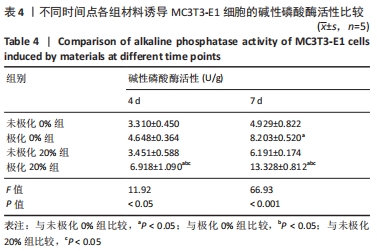Chinese Journal of Tissue Engineering Research ›› 2023, Vol. 27 ›› Issue (3): 367-373.doi: 10.12307/2023.002
Previous Articles Next Articles
Barium titanate/polylactic acid piezoelectric composite film affects adhesion, proliferation, and osteogenic differentiation of MC3T3-E1 cells
Dai Xianglin, Zhang Wenfeng, Yao Xijun, Shang Jiaqi, Huang Qiujin, Ren Yifan, Deng Jiupeng
- School of Stomatology, North China University of Science and Technology, Tangshan 063200, Hebei Province, China
-
Received:2021-11-23Accepted:2022-01-06Online:2023-01-28Published:2022-05-19 -
Contact:Deng Jiupeng, Associate professor, School of Stomatology, North China University of Science and Technology, Tangshan 063200, Hebei Province, China -
About author:Dai Xianglin, Master candidate, School of Stomatology, North China University of Science and Technology, Tangshan 063200, Hebei Province, China -
Supported by:Special Project for the Cultivation of Scientific and Technological Innovation Ability of College and Middle School Students, No. 2021H020909 (to ZWF)
CLC Number:
Cite this article
Dai Xianglin, Zhang Wenfeng, Yao Xijun, Shang Jiaqi, Huang Qiujin, Ren Yifan, Deng Jiupeng. Barium titanate/polylactic acid piezoelectric composite film affects adhesion, proliferation, and osteogenic differentiation of MC3T3-E1 cells[J]. Chinese Journal of Tissue Engineering Research, 2023, 27(3): 367-373.
share this article
Add to citation manager EndNote|Reference Manager|ProCite|BibTeX|RefWorks

由图2可知,钛酸钡粒子在2θ=31.4°呈现较强的晶相衍射峰(图中b区域)。与0%组即纯聚乳酸薄膜材料相比,其他含不同比例钛酸钡的各组复合膜显示出明显的钛酸钡特征峰值(b、c区域均为特征峰)。根据衍射峰特征显示,极化前后各组材料分散在聚乳酸基体中的钛酸钡粒子结构没有发生变化,表明钛酸钡粒子在复合材料制备中具有稳定性;但极化后的复合薄膜中钛酸钡粒子的晶相显示出比未极化组中钛酸钡粒子更强的特征峰,这可能是由于电晕极化提高了聚乳酸基体的结晶度和聚合物链段的规律性[1]。同时,纯聚乳酸在2θ=16.6°附近出现弥散的衍射峰(图中a区域),说明纯聚乳酸膜中的聚合物分子聚集成一个有序结构[28]。当钛酸钡质量分数为5%和10%时,复合材料中的衍射峰位置与纯聚乳酸膜相比无明显偏移。这一结果显示钛酸钡的加入并没有改变衍射峰的位置和数量,说明以上两组钛酸钡含量对聚乳酸晶型结构基本没有影响。但当钛酸钡质量分数为20%,30%和40%时,复合膜中的X射线衍射特征峰与纯聚乳酸相比发生了一定改变,说明钛酸钡粒子的加入破坏了聚乳酸有序排列的分子结构,降低了其分子链的排列密度,当材料受到冲击后,分子链段活动空间增加,冲击强度增加[29]。 2.3 各组复合薄膜材料的水接触角检测结果 见图3。 "

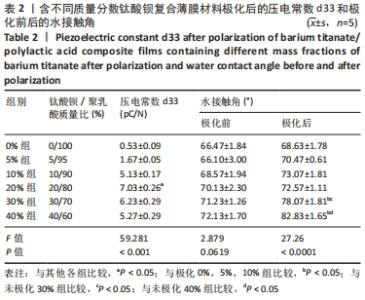
由图3可知,钛酸钡含量和电晕极化处理对材料亲水性的影响不同。未极化复合薄膜材料的接触角比较差异无显著性意义(P > 0.05),这表明该复合材料极化前的亲水性不随钛酸钡含量的变化而改变。极化后处理后,极化30%,40%组的接触角较其他极化组大(P < 0.05),同时极化30%,40%组的水接触角均大于极化前(P < 0.05),亲水性较差。结果表明,钛酸钡含量不同,材料表面粗糙程度不同,当钛酸钡含量为30%及以上时,大体可观察到材料表面粗糙程度更明显,且根据扫描电镜高倍数图像可观察到钛酸钡含量为30%及以上时团聚现象更明显,结合X射线衍射结果分析,高压电晕极化后材料表面分子链密度降低,产生断裂并堆积在表面形成隆起,形成纳米级孔隙,这种纳米级粗糙也会影响材料的亲水性[29]。 由X射线衍射结果可知,5%,10%组聚乳酸基体特征衍射峰与纯聚乳酸相比较并未发生变化,所以极化对于其表面分子链影响不大,极化前后水接触角比较差异无显著性意义(P > 0.05)。20%组的衍射峰虽发生改变,其极化后表面水接触角本应增大,但实际结果却无统计学差异(P > 0.05),这可能与该比例的钛酸钡/聚乳酸复合材料具有良好的分散性和最高的压电常数有关,已有研究证实生物压电材料压电常数越大,水接触角越小、亲水性越好[30]。 用接触角测量仪测试各组材料的静态水接触角统计结果,见表2。 "
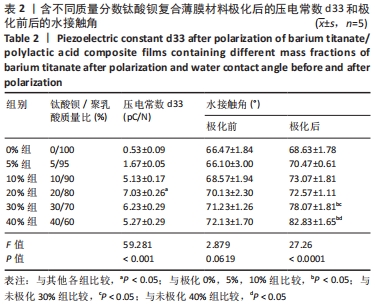
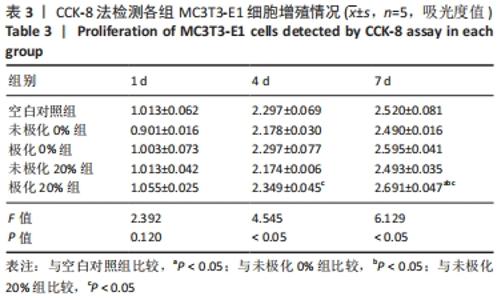
2.4 各组极化处理复合薄膜材料的压电常数结果 已知骨的压电常数为4-11 pC/N[25]。如表2所示,在极化后1周测定各组材料压电常数,可匹配骨骼压电常数范围的组别为10%,20%,30%和40%组,其中20%组的压电常数最高,平均值为(7.03±0.26) pC/N。在一定范围内,随着钛酸钡含量的增加,材料的压电常数升高、压电性能增强。但当钛酸钡含量超过20%时,材料的压电常数在原有基础上不再进一步提高,这可能是由于钛酸钡凝结成团导致膜性能降低,从而极化效果减弱。但是该结果不能代表各组材料压电性能的衰减程度与时效性。 2.5 筛选较佳配比的复合薄膜材料 根据材料理化性能检测结果,从材料表面特征和钛酸钡分散状况来看,未极化0%,5%,10%,20%组有良好的表面特征,表面钛酸钡分散较为均匀;根据X射线衍射材料的晶相分析来看,极化后的复合材料具有更强的衍射峰;根据水接触角测试分析,当钛酸钡含量在30%和40%时,极化会使材料表面亲水能力降低;根据静态压电常数测试得出极化20%组压电常数d33最高,为(7.03±0.26) pC/N。所以,根据上述性能综合选择出极化20%组为实验组,选择未极化20%组、极化0%组和未极化0%组为对照组进行后续细胞实验。 2.6 复合压电薄膜材料的细胞相容性 2.6.1 细胞增殖实验结果 见表3。"
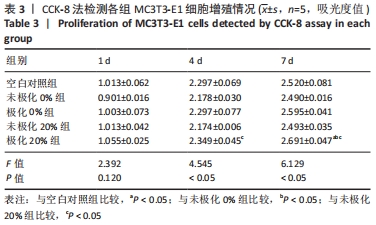
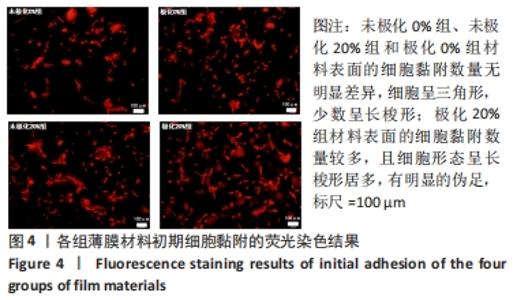
在培养1,4,7 d时,各组细胞增殖吸光度值均呈现增加趋势,说明随着时间的延长细胞数量呈增长趋势;培养第1天时,各组细胞增殖吸光度值比较差异无显著性意义(P > 0.05);培养第4天时,各组细胞增殖吸光度值与空白对照组比较差异均无显著性意义(P > 0.05),极化20%组细胞增殖吸光度值高于未极化20%组(P < 0.05);培养第7天时,极化20%组细胞增殖吸光度值高于空白对照组、未极化0%组和未极化20%组(P < 0.05),与极化0%组比较差异无显著性意义(P > 0.05)。结果表明,各组材料与空白对照组相比并不影响细胞增殖,细胞增殖能力均良好。其中极化20%组促细胞增殖能力较空白对照组和未极化组好,这是由于极化使压电材料表面带有一定稳定排列的电荷,而电荷产生的电刺激在一定程度上可以促进细胞的增殖[31]。 2.6.2 细胞黏附观察结果 荧光染色:共培养12 h后,各组材料表面的细胞黏附状况,见图4。荧光染色结果显示,未极化0%组、未极化20%组和极化0%组材料表面的细胞黏附数量无明显差异,细胞呈三角形,少数呈长梭形;极化20%组材料表面的细胞黏附数量较多,且细胞形态呈长梭形居多,有明显的伪足。 "
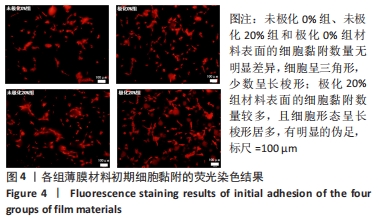
| [1] ZHANG X, ZHANG C, LIN Y, et al. Nanocomposite Membranes Enhance Bone Regeneration Through Restoring Physiological Electric Microenvironment. ACS Nano. 2016;10(8):7279-7286. [2] LEPPIK L, OLIVEIRA KMC, BHAVSAR MB, et al. Electrical stimulation in bone tissue engineering treatment. Eur J Trauma Emerg Surg. 2020;46(2):231-244. [3] 朱子馨,周俊余,苟雪.可拉伸的钛酸钡压电膜上细胞黏附行为的研究[J].医用生物力学,2021,36(S1):164. [4] 熊莹,许燕,周建平,等.组织工程研究中的电活性生物材料[J].中国组织工程研究,2019,23(34):5523-5530. [5] ZHENG T, HUANG Y, ZHANG X, et al. Mimicking the electrophysiological microenvironment of bone tissue using electroactive materials to promote its regeneration. J Mater Chem B. 2020;8(45):10221-10256. [6] KHARE D, BASU B, DUBEY AK. Electrical stimuLation and piezoelectric biomaterials for bone tissue engineering applications. Biomaterials. 2020;258:120280. [7] TANDON B, BLAKER JJ, CARTMELL SH. Piezoelectric materials as stimulatory biomedical materials and scaffolds for bone repair. Acta Biomater. 2018;73:1-20. [8] KAO FC, CHIU PY, TSAI TT, et al. The application of nanogenerators and piezoelectricity in osteogenesis. Sci Technol Adv Mater. 2019;20(1):1103-1117. [9] TANG Y, WU C, WU Z, et al. Fabrication and in vitro biological properties of piezoelectric bioceramics for bone regeneration. Sci Rep. 2017;7:43360. [10] 胡龙.HA/BaTiO_3压电仿生骨植入材料的制备及性能研究[D].西安:西安理工大学,2014. [11] LIU W, LI X, JIAO Y, et al. Biological Effects of a Three-Dimensionally Printed Ti6Al4V Scaffold Coated with Piezoelectric BaTiO3 Nanoparticles on Bone Formation. ACS Appl Mater Interfaces. 2020;12(46):51885-51903. [12] EHTERAMI A, KAZEMI M, NAZARI B, et al. Fabrication and characterization of highly porous barium titanate based scaffold coated by Gel/HA nanocomposite with high piezoelectric coefficient for bone tissue engineering applications. J Mech Behav Biomed Mater. 2018;79:195-202. [13] LI Y, LIAO C, TJONG SC. Electrospun Polyvinylidene Fluoride-Based Fibrous Scaffolds with Piezoelectric Characteristics for Bone and Neural Tissue Engineering. Nanomaterials (Basel). 2019;9(7):952. [14] AMARO L, CORREIA DM, MARQUES-ALMEIDA T, et al. Tailored Biodegradable and Electroactive Poly(Hydroxybutyrate-Co-Hydroxyvalerate) Based Morphologies for Tissue Engineering Applications. Int J Mol Sci. 2018;19(8):2149. [15] AMARO L, CORREIA DM, MARTINS PM, et al. Morphology Dependence Degradation of Electro- and Magnetoactive Poly(3-hydroxybutyrate-co-hydroxyvalerate) for Tissue Engineering Applications. Polymers (Basel). 2020; 12(4):953. [16] 郭莉莉.聚L-乳酸基驻极体膜的制备及其性能研究[D].郑州:郑州大学,2013. [17] LI Y, DAI X, BAI Y, et al. Electroactive BaTiO3 nanoparticle-functionalized fibrous scaffolds enhance osteogenic differentiation of mesenchymal stem cells. Int J Nanomedicine. 2017;12:4007-4018. [18] 段瑞侠,陈金周,刘文涛,等.聚乳酸基压电材料的研究和应用[J/OL].材料导报:1-18[2021-11-17].http://kns.cnki.net/kcms/detail/50.1078.TB. 20211115.1801.037.html. [19] SAEIDI B, DERAKHSHANDEH MR, CHERMAHINI MD, et al. Novel Porous Barium Titanate/Nano-Bioactive Glass Composite with High Piezoelectric Coefficient for Bone Regeneration Applications. J Mater Eng Perform. 2020;29(8):1-8. [20] 魏子钦,夏翔,李勤,等.钛酸钡/硅酸钙复合生物活性压电陶瓷的制备及性能研究[J/OL].无机材料学报:1-8[2021-12-19].http://kns.cnki.net/kcms/detail/31.1363.TQ.20211118.1850.026.html. [21] 朱子馨,周俊余,苟雪.可拉伸的钛酸钡压电膜上细胞黏附行为的研究[J].医用生物力学,2021,36(S1):164. [22] 刘国峰.自供电刺激骨支架的激光增材制造及其性能研究[D].赣州:江西理工大学,2021. [23] LIU J, GU H, LIU Q, et al. An intelligent material for tissue reconstruction: The piezoelectric property of polycaprolactone/barium titanate composites. Mater Lett. 2019;236(FEB.1):686-689. [24] MANCUSO E, SHAH L, JINDAL S, et al. Additively manufactured BaTiO3 composite scaffolds: A novel strategy for load bearing bone tissue engineering applications. Mater Sci Eng C Mater Biol Appl. 2021;126:112192-112192. [25] PROKHOROV E, BÁRCENAS GL, ESPAÑA SÁNCHEZ BL, et al. Chitosan-BaTiO3 nanostructured piezopolymer for tissue engineering. Colloids Surf B Biointerfaces. 2020;196:111296. [26] BAGCHI A, MEKA SR, RAO BN, et al. Perovskite ceramic nanoparticles in polymer composites for augmenting bone tissue regeneration. Nanotechnology. 2014; 25(48):485101. [27] 傅志昂.辐射法制备有机-无机杂化纳米粒子及其在高分子材料中的应用研究[D].北京:中国科学院大学(中国科学院上海应用物理研究所),2021. [28] 尹兴,孙诚,付春英,等.纳米二氧化钛/聚乳酸抗菌薄膜的制备和性能[J].包装工程,2017,38(15):36-40. [29] 任煜,李猛,尤祥银.驻极处理对聚乳酸熔喷材料性能的影响[J].纺织学报, 2015,36(9):13-17. [30] 吴聪.钛表面生物压电涂层的构建及其骨修复促进机制研究[D].西安:西安理工大学,2021. [31] 闫欢欢.贻贝仿生导电性苯胺齐聚物生物材料的制备及在组织工程中的应用[D].北京:中国科学技术大学,2020. [32] 曹钰彬,刘畅,潘韦霖,等.引导骨再生屏障膜改良的研究进展[J].华西口腔医学杂志,2019(3):325-329. [33] LI X, WEI L, LI J, et al. Multifunctional SDF-1-loaded hydroxyapatite/polylactic acid membranes promote cell recruitment, immunomodulation, angiogenesis, and osteogenesis for biomimetic bone regeneration. Appl Mater Today. 2021;22:100942. [34] 封小霞,侯玮玮,金晓婷,等.构建聚乳酸-羟基乙酸电纺丝-壳聚糖电喷微球牙周仿生膜[J].中国组织工程研究,2020,24(4):511-516. [35] 方炜.聚乳酸/生物玻璃引导骨再生膜制备及体外实验研究[D].广州:南方医科大学,2015. [36] CHEN W, YU Z, PANG J, et al. Fabrication of Biocompatible Potassium Sodium Niobate Piezoelectric Ceramic as an Electroactive Implant. Materials (Basel). 2017;10(4):345. [37] 田春燕.电活性生物骨修复复合材料(BT-HA)/PVDF的制备和性能研究[D].北京:北京化工大学,2009. [38] 朱培君,赖春花,程鸣威,等.电活性生物膜通过调控巨噬细胞极化促进骨再生修复的体外研究[J].实用医学杂志,2021,37(10):1257-1262. [39] 何逸恒,程鸣威,朱培君,等.电活性生物膜促进大鼠的体内成骨[J].中国组织工程研究,2022,26(28):4662-4667. |
| [1] | Wang Shanshan, Shu Qing, Tian Jun. Physical factors promote osteogenic differentiation of stem cells [J]. Chinese Journal of Tissue Engineering Research, 2024, 28(7): 1083-1090. |
| [2] | Wang Wen, Zheng Pengpeng, Meng Haohao, Liu Hao, Yuan Changyong. Overexpression of Sema3A promotes osteogenic differentiation of dental pulp stem cells and MC3T3-E1 [J]. Chinese Journal of Tissue Engineering Research, 2024, 28(7): 993-999. |
| [3] | Wang Wenchi, Wu Ruiqi, Huang Jierong, Zhu Lifeng, Cui Xianqin, Li Dongzong, Chen Wenhui, Lin Chunting, Cui wei. Molecular mechanism of naringin in prevention and treatment of osteoporosis [J]. Chinese Journal of Tissue Engineering Research, 2024, 28(34): 5528-5535. |
| [4] | Shi Xian, Han Chunqing, Hu Anran, Kuang Shuyun, Ran Yimeng, Wu Yu. Atf7ip is a negative regulator of bone morphogenetic protein 2 promoting osteogenic differentiation in mouse embryonic adult cells [J]. Chinese Journal of Tissue Engineering Research, 2024, 28(31): 4931-4936. |
| [5] | Lin Zhanying, Lin Ziyun, Huang Liuyan, Zhang Wenxi, Zuo Changqing. Overexpression of long non-coding RNA Gm16104 affects osteogenic differentiation of C3H10T1/2 mesenchymal stem cells [J]. Chinese Journal of Tissue Engineering Research, 2024, 28(31): 4964-4969. |
| [6] | Zhang Aili, Huang Jiazheng, Fan Wen, Li Yihuan, Li Shuang, Gan Xuewen, Xiong Ying. Establishing equivalent model to verify the precision of personalized bone model rapidly [J]. Chinese Journal of Tissue Engineering Research, 2024, 28(30): 4795-4799. |
| [7] | Zhang Jie, Xiao Tianjiao, Li Li, Kang Jiabing, Zhan Jifan, Wei Yan, Tian Ai. Interleukin-4 regulates macrophage polarization and osteogenic differentiation of bone marrow mesenchymal stem cells [J]. Chinese Journal of Tissue Engineering Research, 2024, 28(25): 3960-3966. |
| [8] | Han Yue, Wang Yufei, Liu Wanqing, Dong Ming, Niu Weidong. Effects of icariin on proliferation and differentiation of MC3T3-E1 cells in an inflammatory environment [J]. Chinese Journal of Tissue Engineering Research, 2024, 28(23): 3709-3714. |
| [9] | An Ran, Shao Guo, Zhang Chunyang. Effect of dura mater on enhancement of cranial osteogenesis in rats [J]. Chinese Journal of Tissue Engineering Research, 2024, 28(22): 3478-3483. |
| [10] | Liu Yan, Zheng Xuexin. Performance of 3D-printed polylactic acid-nano-hydroxyapatite/chitosan/doxycycline antibacterial scaffold [J]. Chinese Journal of Tissue Engineering Research, 2024, 28(22): 3532-3538. |
| [11] | Gou Qiutong, Luo Wenhao, Wang Pin, Lan Yuyan, Liu Min, Huang Haixia. Berberine promotes osteogenic differentiation of bone marrow mesenchymal stem cells in a high-glucose environment [J]. Chinese Journal of Tissue Engineering Research, 2024, 28(19): 2974-2980. |
| [12] | Xie Ting, Liu Tingting, Zeng Xuehui, Li Yamin, Zhou Panghu, Yi Nianhua. Vitamin D3 attenuates high-glucose exposure-induced oxidative stress to promote osteogenic differentiation of human umbilical cord mesenchymal stem cells [J]. Chinese Journal of Tissue Engineering Research, 2024, 28(19): 2981-2987. |
| [13] | Song Yue, Shu Qing, Jia Shaohui, Tian Jun. Photobiomodulation-induced osteogenic differentiation of mesenchymal stem cells [J]. Chinese Journal of Tissue Engineering Research, 2024, 28(19): 3069-3075. |
| [14] | Liu Ziyang, Lao An, Xu Chenci, AiRi Shin, Wu Jiaqing, Liu Jiaqiang. Polycaprolactone-polydopamine-AOPDM1 scaffold promotes bone formation in a high-glucose environment [J]. Chinese Journal of Tissue Engineering Research, 2024, 28(17): 2667-2674. |
| [15] | Qin Siyu, Song Li, Chen Junyu, Li Yijun, Wan Qianbing. Preparation and osteoinductivity of piezoelectric polyvinylidene fluoride foam-based scaffold [J]. Chinese Journal of Tissue Engineering Research, 2024, 28(17): 2682-2689. |
| Viewed | ||||||
|
Full text |
|
|||||
|
Abstract |
|
|||||
